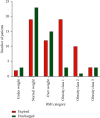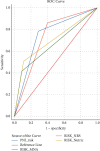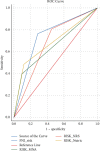Evaluation of the Relationship between Nutritional Status of COVID-19 Patients Admitted to the ICU and Patients' Prognosis: A Cohort Study
- PMID: 35865866
- PMCID: PMC9295016
- DOI: 10.1155/2022/5016649
Evaluation of the Relationship between Nutritional Status of COVID-19 Patients Admitted to the ICU and Patients' Prognosis: A Cohort Study
Abstract
Background: Malnutrition in COVID-19 critically ill patients can lead to poor prognosis. This study aimed to evaluate the association between nutritional status (or risk) and the prognosis of critically ill COVID-19 patients. In this study, prognosis is the primary outcome of "hospital mortality" patients. The second outcome is defined as "need for mechanical ventilation."
Methods and materials: In this single-center prospective cohort study, 110 patients admitted to the Intensive Care Unit of Imam Khomeini Hospital Complex (Tehran, Iran) between April and September 2021 were enrolled. Participants formed a consecutive sample. MNA-SF, NRS-2002, mNUTRIC, and PNI scores were used to evaluate nutritional assessment. Patients' lab results and pulse oximetric saturation SpO2/FiO2 (SF) ratio at the time of intensive care unit (ICU) admission were collected. Patients were screened for nutritional status and categorized into two groups, patients at nutritional risk and nonrisk.
Results: Sixty-five (59.1%) of all patients were men. The overall range of age was 52 ± 15. Thirty-six (32.7%) of patients were obese (BMI ≥ 30). The hospital mortality rate was 59.1% (n = 65). According to the different criteria, malnutrition rate was 67.3% (n = 74) (NRS), 28.2% (n = 31) (MNA), 34.5% (n = 38) (mNUTRIC), and 58.2% (n = 64) (PNI). There was a statistically significant association between chronic kidney disease (CKD) and mNUTRIC risk (OR = 13.5, 95% CI (1.89-16.05), P=0.002), diabetes mellitus (DM) and MNA risk (OR = 2.82, 95% CI (1.01-7.83), P=0.041), hypertension (HTN) and MNA risk (OR = 5.63, 95% CI (2.26-14.05), P < 0.001), and malignancy and mNUTRIC risk (P=0.048). The nutritional risk (all tools) significantly increased the odds of in-hospital death and need for mechanical ventilation. The length of stay was not significantly different in malnourished patients.
Conclusion: In the critical care setting of COVID-19 patients, malnutrition is prevalent. Malnutrition (nutritional risk) is associated with an increased risk of need for mechanical ventilation and in-hospital mortality. Patients with a history of HTN, CKD, DM, and cancer are more likely to be at nutritional risk at the time of ICU admission.
Copyright © 2022 Parsa Mohammadi et al.
Conflict of interest statement
The authors declare that there are no conflicts of interest.
Figures
Similar articles
-
Comparison of nutritional risk status assessment tools in predicting 30-day survival in critically ill COVID-19 pneumonia patients.Ann Saudi Med. 2022 Jul-Aug;42(4):236-245. doi: 10.5144/0256-4947.2022.236. Epub 2022 Aug 4. Ann Saudi Med. 2022. PMID: 35933605 Free PMC article.
-
The modified NUTRIC score can be used for nutritional risk assessment as well as prognosis prediction in critically ill COVID-19 patients.Clin Nutr. 2021 Feb;40(2):534-541. doi: 10.1016/j.clnu.2020.05.051. Epub 2020 Jun 5. Clin Nutr. 2021. PMID: 32527576 Free PMC article.
-
Association between the modified Nutrition Risk in Critically Ill (mNUTRIC) score and clinical outcomes in the intensive care unit: a secondary analysis of a large prospective observational study.BMC Anesthesiol. 2021 Sep 8;21(1):220. doi: 10.1186/s12871-021-01439-x. BMC Anesthesiol. 2021. PMID: 34496742 Free PMC article.
-
Nutritional risk in critically ill patients: how it is assessed, its prevalence and prognostic value: a systematic review.Nutr Rev. 2020 Dec 1;78(12):1052-1068. doi: 10.1093/nutrit/nuaa031. Nutr Rev. 2020. PMID: 32529226
-
Importance of nutritional assessment tools in the critically ill patient: A systematic review.Front Nutr. 2023 Jan 30;9:1073782. doi: 10.3389/fnut.2022.1073782. eCollection 2022. Front Nutr. 2023. PMID: 36793999 Free PMC article.
Cited by
-
Fungal Infections in the ICU during the COVID-19 Era: Descriptive and Comparative Analysis of 178 Patients.J Fungi (Basel). 2022 Aug 21;8(8):881. doi: 10.3390/jof8080881. J Fungi (Basel). 2022. PMID: 36012869 Free PMC article.
-
The role of nutritional risk evaluation in predicting adverse outcomes among patients with severe COVID-19 in Vietnam.Front Nutr. 2023 Oct 5;10:1245816. doi: 10.3389/fnut.2023.1245816. eCollection 2023. Front Nutr. 2023. PMID: 37867496 Free PMC article.
-
Risk of Malnutrition in Hospitalized COVID-19 Patients: A Systematic Review and Meta-Analysis.Nutrients. 2022 Dec 10;14(24):5267. doi: 10.3390/nu14245267. Nutrients. 2022. PMID: 36558436 Free PMC article.
-
The Link between Inflammation, Lipid Derivatives, and Microbiota Metabolites in COVID-19 Patients: Implications on Eating Behaviors and Nutritional Status.Int J Mol Sci. 2024 Jul 19;25(14):7899. doi: 10.3390/ijms25147899. Int J Mol Sci. 2024. PMID: 39063142 Free PMC article. Review.
References
-
- Mohammadi S., Varpaei H. A., Mohammadi M. COVID-19 waterfall. Archive Neuroscience . 2021;8(3) doi: 10.5812/ans.118309.e118309 - DOI
-
- Mohammadi P., Aldin Varpaei H., Mohammadi M. Assessment of nutritional risks in COVID-19 patients. Journal of Iranian Medical Council . 2022;4(4):344–346.
LinkOut - more resources
Full Text Sources
Miscellaneous





